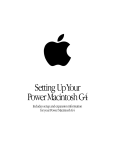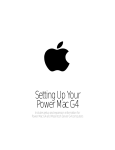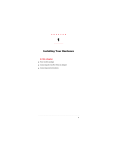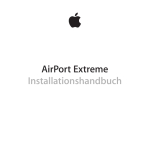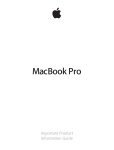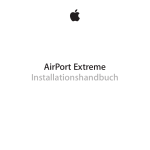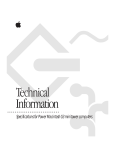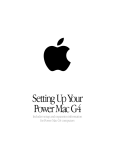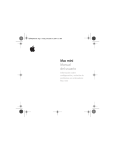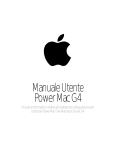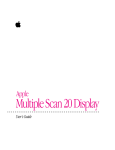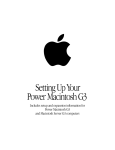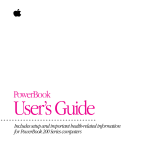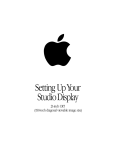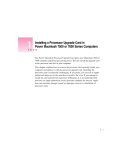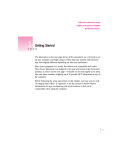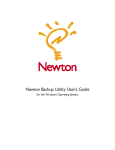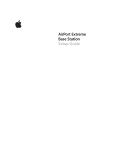Download Apple PowerShot G3 User's Manual
Transcript
Setting Up Your Macintosh Server G3 Includes setup and expansion information for the Macintosh Server G3 with Mac OS X Server K Apple Computer, Inc. © 1999 Apple Computer, Inc. All rights reserved. Under the copyright laws, this manual may not be copied, in whole or in part, without the written consent of Apple. The Apple logo is a trademark of Apple Computer, Inc., registered in the U.S. and other countries. Use of the “keyboard” Apple logo (Option-Shift-K) for commercial purposes without the prior written consent of Apple may constitute trademark infringement and unfair competition in violation of federal and state laws. Every effort has been made to ensure that the information in this manual is accurate. Apple is not responsible for printing or clerical errors. Apple Computer, Inc. 1 Infinite Loop Cupertino, CA 95014-2084 408-996-1010 http://www.apple.com Apple, the Apple logo, FireWire, Mac, Mac OS X Server, Macintosh, and PlainTalk are trademarks of Apple Computer, Inc., registered in the U.S. and other countries. The FireWire logo is a trademark of Apple Computer. NuBus is a trademark of Texas Instruments. PowerPC and the PowerPC logo are trademarks of International Business Machines Corporation, used under license therefrom. This product includes software developed by the Apache group for use in the Apache HTTP server project (www.apache.org). UNIX is a registered trademark in the United States and other countries, licensed exclusively through X/Open company, Ltd. Manufactured under license from Dolby Laboratories. “Dolby” and the double-D symbol are trademarks of Dolby Laboratories. Confidential Unpublished Works. © 1992–1997 Dolby Laboratories, Inc. All rights reserved. Other company and product names mentioned herein are trademarks of their respective companies. Mention of third-party products is for informational purposes only and constitutes neither an endorsement nor a recommendation. Apple assumes no responsibility with regard to the performance or use of these products. Simultaneously published in the United States and Canada. Contents Communications Regulation Information 6 Laser Information 7 Preface Introducing the Macintosh Server G3 9 Hardware and Software Features 10 Hardware Features 10 Software Features 10 Hardware and Software Limitations in Mac OS X Server 11 1 Setting Up 13 Positioning the Computer 13 Your Server at a Glance 14 Your Server’s Ports and Connectors 16 Plugging In the Server 18 Connecting a Monitor 21 Connecting the Mouse and the Keyboard to the Server 23 Connecting to an Ethernet Network 25 Securing the Server 29 What’s Next 29 2 Working Inside the Server 31 About Memory 32 DRAM Configurations 33 About Internal Storage Options 33 Additional Wide Ultra2 SCSI Drives 35 Other Types of SCSI Drives 35 3 About PCI Expansion Cards 35 Expansion Card Power Requirements 36 About the Server’s Battery 36 Installing a PCI Expansion Card, Memory, Replacement Battery, or Internal Storage Device 37 Opening the Server 37 Installing DRAM 40 Installing a Hard Disk or Other Internal Storage Device 42 Installing a PCI Expansion Card 52 Replacing the Battery 55 Closing the Server 56 3 Starting Up Your Server 59 Setting Up Your Server and Turning It On 59 Turning the Server Off 61 Problems Turning Your Server On? 61 Problems With an Apple USB Mouse or Keyboard 62 Using the Server Without a Monitor 63 Restoring Your Server’s Software 63 Before Restoring Your Software 64 Restoring in Place 64 Erasing Your Hard Disk 65 4 Health, Safety, and Maintenance 67 Health-Related Information About Computer Use 67 Musculoskeletal Discomfort 68 Eye Fatigue 68 Arranging Your Work Area 69 Avoiding Fatigue 70 What About Electromagnetic Emissions? 71 Safety Instructions 71 Handling Your Computer Equipment 72 Handling the Monitor 73 Handling the Keyboard 73 Handling CD-ROM Discs 73 4 Contents Power Supply 75 Cleaning Your Equipment 75 Cleaning the Computer Case 75 Cleaning the Monitor 76 Cleaning the Mouse 76 Locking and Unlocking the Mouse 77 Contents 5 Communications Regulation Information FCC Compliance Statement This device complies with part 15 of the FCC rules. Operation is subject to the following two conditions: (1) This device may not cause harmful interference, and (2) this device must accept any interference received, including interference that may cause undesired operation. See instructions if interference to radio or television reception is suspected. Radio and Television Interference The equipment described in this manual generates, uses, and can radiate radio-frequency energy. If it is not installed and used properly—that is, in strict accordance with Apple’s instructions—it may cause interference with radio and television reception. This equipment has been tested and found to comply with the limits for a Class B digital device in accordance with the specifications in Part 15 of FCC rules. These specifications are designed to provide reasonable protection against such interference in a residential installation. However, there is no guarantee that interference will not occur in a particular installation. You can determine whether your computer system is causing interference by turning it off. If the interference stops, it was probably caused by the computer or one of the peripheral devices. If your computer system does cause interference to radio or television reception, try to correct the interference by using one or more of the following measures: m Turn the television or radio antenna until the interference stops. m Move the computer to one side or the other of the television or radio. m Move the computer farther away from the television or radio. m Plug the computer into an outlet that is on a different circuit from the television or radio. (That is, make certain the computer and the television or radio are on circuits controlled by different circuit breakers or fuses.) If necessary, consult an Apple-authorized service provider or Apple. See the service and support information that came with your Apple product. Or, consult an experienced radio/television technician for additional suggestions. Important Changes or modifications to this product not authorized by Apple Computer, Inc., could void the FCC Compliance and negate your authority to operate the product. This product was tested for FCC compliance under conditions that included the use of Apple peripheral devices and Apple shielded cables and connectors between system components. It is important that you use Apple peripheral devices and shielded cables and connectors between system components to reduce the possibility of causing interference to radios, television sets, and other electronic devices. You can obtain Apple peripheral devices and the proper shielded cables and connectors through an Apple-authorized dealer. For non-Apple peripheral devices, contact the manufacturer or dealer for assistance. Responsible party (contact for FCC matters only): Robert Steinfeld, Apple Computer, Inc., 1 Infinite Loop, Cupertino, CA 95014-2084, 408-974-2618. Industry Canada Statement This Class B device meets all requirements of the Canadian interference-causing equipment regulations. Cet appareil numérique de la Classe B respecte toutes les exigences du Règlement sur le matériel brouilleur du Canada. 6 Communications Regulation Information VCCI Class B Statement Laser Information Making adjustments or performing procedures other than those specified in your equipment’s manual may result in hazardous radiation exposure. Warning Do not attempt to disassemble the cabinet containing the laser. The laser beam used in this product is harmful to the eyes. The use of optical instruments, such as magnifying lenses, with this product increases the potential hazard to your eyes. For your safety, have this equipment serviced only by an Apple-authorized service provider. If you have an internal Apple CD-ROM drive in your computer, your computer is a Class 1 laser product. The Class 1 label, located in a user-accessible area, indicates that the drive meets minimum safety requirements. A service warning label is located in a service-accessible area. The labels on your product may differ slightly from the ones shown here. Class 1 label Service warning label High-Risk Activities Warning This computer system is not intended for use in the operation of nuclear facilities, aircraft navigation or communications systems, or air traffic control machines, or for any other uses where the failure of the computer system could lead to death, personal injury or severe environmental damage. Laser Information 7 P R E F A C E Introducing the Macintosh Server G3 The Macintosh Server G3 is Apple’s first Mac OS X Server–based computer, offering a variety of services: m Web application deployment platform m World Wide Web and FTP server m QuickTime Streaming server m Startup server for Macintosh client computers that can start up from a server m File and Print server for Macintosh client The Macintosh Server G3’s powerful operating system, Mac OS X Server, combines the ease of use of Mac OS with the power of a UNIX®-based system. Mac OS X Server offers robust, industry-standard networking and Internet support across platforms, scalable network administration, user-level security, and a high degree of stability through memory protection. 9 Hardware and Software Features Hardware Features Your server’s hardware includes: m a high-speed PowerPC microprocessor m PCI slots to support internal expansion m high-capacity internal disk drives and fast CD-ROM drive m powerful graphics and Ethernet support The technical specifications for all of these features are listed in the Technical Information booklet that came with your computer. Software Features Your server comes with the following software already installed: m Mac OS X Server m Apache Web server m AppleShare file and print services m QuickTime Streaming server m NetBoot server software m WebObjects Enterprise Developer 10 Preface Hardware and Software Limitations in Mac OS X Server Mac OS X Server does not support certain hardware and software features: m FireWire m USB devices other than the USB keyboard and mouse m DVD-ROM discs (Mac OS X Server can read CD-ROM discs in DVD-ROM drives, however.) m PPP (Point-to-Point Protocol) or Internet connection via modem m Speech recognition ( You can use an application called Sound.app, located in your /System/Demos folder, to record sounds in Mac OS X Server.) m Most add-on PCI cards or other devices requiring drivers that are not built into Mac OS X Server m Standard audio discs and photo CDs Introducing the Macintosh Server G3 11 Computer Monitor Apple USB mouse Apple USB keyboard Apple keyboard extension cable Computer power cord Mac-to-VGA adapter Monitor cable Monitor power cord (sometimes built into the monitor) (sometimes built into the monitor) C H A P T E R 1 1 Setting Up The illustration on the preceding page shows all the equipment you need to set up your computer and begin using it. (The monitor you purchased may look different.) If you want to install additional disk drives, memory, or PCI cards inside the computer before you set up, turn to Chapter 2, “Working Inside the Server,” on page 31. Positioning the Computer You can pick up the computer by any of its handles. Place the computer on a sturdy, flat surface near a grounded wall outlet. Your computer is designed to be placed on the floor to conserve desk space, but you can place it on any stable, flat surface. Position the computer so that m the CD-ROM drive tray has space to open in front m the power cable connector does not press against a wall or other object m nothing obstructs air flow to the fan in the rear of the computer 13 Your Server at a Glance Monitor CD-ROM drive C CD-ROM drive Open button Speaker ® Power button Power button / Power-on light ¥ Programmer’s button Apple USB keyboard Apple USB mouse P Reset button 14 Chapter 1 CD-ROM drive Works with CD-ROM discs C CD-ROM drive Open button Opens the drive tray ® Power button Turns your computer on and off Power-on light A green light indicates that the computer is on. An amber light indicates the computer is in sleep. P Reset button This button forces the computer to restart. Use the reset button only when you cannot restart your computer with any of the recommended methods. ¥ Programmer’s button This button interrupts the normal operation of the computer’s software. Only computer programmers should use this button. Setting Up 15 Your Server’s Ports and Connectors FireWire ports (2) (FireWire is not supported by Mac OS X Server software) V Apple Desktop Bus (ADB) port G Ethernet port (10/100 twisted-pair Ethernet) Lockable cover latch ≤ Power socket Monitor power socket ™ Monitor port Access cover for expansion slot USB ports (2) (Only the Apple USB keyboard and mouse are supported by Mac OS X Server software) ≈ Sound input port - Sound output port 16 Chapter 1 4-port Ethernet card (10/100 twisted-pair Ethernet) Wide Ultra2 SCSI card F Security lock port FireWire ports This feature is not supported by Mac OS X Server. V Apple Desktop Bus (ADB) port Connects your Macintosh to an input device, such as a keyboard or a trackball G 10/100 twisted-pair Ethernet port Connects your Macintosh to a high-speed Ethernet network USB ports Connects your Macintosh to an Apple USB keyboard, or mouse. Other USB peripheral devices are not supported by Mac OS X Server. ≈ Sound input port Connects your Macintosh to an Apple PlainTalk microphone or other audio input equipment - Sound output port Connects your Macintosh to headphones, externally powered (amplified) speakers, or other audio output equipment F Lockable cover latch and security lock port You can attach a security lock to your Macintosh and to its back panel to secure the internal components. See your computer products retailer for security lock devices that work with your server. Monitor power socket Provides a convenient place to plug in a monitor power cord ≤ Power socket Connects to the computer’s power cord ™ Monitor port Connects a monitor to your Macintosh Access covers for expansion slots (4) Your Macintosh supports up to four peripheral component interconnect (PCI) cards. In most configurations, a card installed in the slot labeled 1 provides a port for the monitor. The covered slot, labeled 2 provides additional expansion capability. The slot labeled 3 provides four Ethernet networking ports and slot 4 provides the SCSI port. Setting Up 17 Plugging In the Server Before you plug your Macintosh into a wall socket, carefully read all the setup instructions in this chapter. Then, before you connect any other equipment, follow the instructions in this section to plug it in. When you are ready to begin, follow these steps: 1 Make sure the voltage switch on the back of the computer is set for the kind of voltage system to which you will be connecting. Check to see that the voltage switch on the back of your computer is properly set before you plug it in. If you need to change the setting, insert a small screwdriver in this slot and slide the switch. Set the switch to show “115” for AC voltages in the 100–120 V range. Set the switch to show “230” for AC voltages in the 200–240 V range. The voltage switch must be set correctly to avoid damaging your computer. An adhesive label showing how to set the voltage may partly cover the voltage switch and power socket. Remove the label. Look at the table “Voltage Switch Settings for Different Locations,” next. 18 Chapter 1 . Voltage switch settings for different locations Country Switch Setting Bermuda, Canada, Jamaica, Japan, Mexico, Philippines, Puerto Rico, Saudi Arabia, Taiwan, United States, Venezuela 115 Bahrain, Brazil, France, Indonesia, Italy, Lebanon, Peru, South Korea, Spain1 115 or 230 Australia, Austria, Bosnia and Herzegovina, Belgium, Chile, China (People’s Republic, including Hong Kong), Croatia, Czech Republic, Denmark, Egypt, Finland, the former Yugoslav Republic of Macedonia, Germany, Greece, Greenland, Hungary, Iceland, India, Iran, Ireland, Israel, Jordan, Kuwait, Liechtenstein, Luxembourg, Malta, Nepal, the Netherlands, New Zealand, Northern Ireland, Norway, Oman, Pakistan, Papua New Guinea, Paraguay, Poland, Portugal, Qatar, Romania, Russia and the Commonwealth of Independent States (CIS), Serbia and Montenegro, Singapore, Slovakia, Slovenia, South Africa, Sweden, Switzerland, United Arab Emirates, United Kingdom, Yemen 230 1 These countries employ more than one type of power source voltage. Ask your local power provider which switch setting to use for your city or region. Setting Up 19 2 Plug one end of the computer’s power cord into the recessed power socket marked with the symbol (≤) on the back of the computer. Warning To prevent electrical shock, fire, or damage to the computer, the power cord must fit completely over the prongs inside the socket. Power cord socket Power cord plug 3 Plug the other end of the power cord into a three-hole grounded outlet or power strip. The plug grounds the computer and protects it from electrical damage while you set up. Make sure the computer is located near an outlet or power strip and that you can easily reach the plug to disconnect the computer in an emergency. The only way to completely disconnect power from the computer is by unplugging one end of the power cord from the outlet or power strip or from the back of the computer. Important Warning This equipment is intended to be electrically grounded. Your Macintosh is equipped with a three-wire grounding plug–a plug that has a third (grounding) pin. This plug will fit only a grounded AC outlet. This is a safety feature. If you are unable to insert the plug into the outlet, contact a licensed electrician to replace the outlet with a properly grounded outlet. Do not defeat the purpose of the grounding plug! 20 Chapter 1 Connecting a Monitor You connect a monitor to the computer’s monitor port. Before you connect the monitor, check the instructions that came with the monitor for additional information. You can get additional information on ergonomics, health and safety considerations, and maintenance in Chapter 4 of this manual. To connect the monitor, follow these steps: 1 Place the monitor near the computer. 2 Connect the monitor power cord to the monitor. Some monitors already have the cord attached. 3 Plug the power cord into a grounded electrical socket or the back of the computer. Check the documentation that came with the monitor to find out where to plug it in. Warning The monitor power socket on the back of the computer uses the same voltage level as the electrical outlet to which the computer is connected. To protect your monitor, be sure to use the appropriate adapter or voltage converter, if one is necessary. Attach the monitor cable to the monitor; then attach the monitor cable to the monitor port on the back of the computer. Monitor power socket ™ Monitor port Monitor power cord Monitor cable Some monitors have the cable attached. Check the monitor’s manual for any additional instructions. Setting Up 21 m If you have a monitor with a high-density D-Sub 15 ( VGA standard) connector, connect the monitor cable directly to the computer’s monitor port. m Some Apple monitors have a DB-15 connector. If your monitor has a DB-15 connector, attach the Mac-to-VGA adapter that came with your computer to the computer’s monitor port and then attach the monitor cable to the adapter. Monitor port on the computer Monitor port on the computer Mac-to-VGA adapter (your adapter may look different) Connector on VGA and some Apple monitor cables (D-Sub 15 connector) 22 Chapter 1 Connector on some Apple monitor cables (DB-15 connector) Connecting the Mouse and the Keyboard to the Server You can connect a USB or ADB keyboard and mouse to your computer. The following section contains instructions for connecting the Apple USB keyboard and mouse. If you want to use an ADB keyboard and mouse, skip to the next section. Connecting the Apple USB Keyboard and Mouse to the Server 1 Connect the optional keyboard extension cable that came with the computer to the end of the cable built into the Apple USB keyboard. You can skip this step if you have the computer set up on a desk or table and can work comfortably without the extension cable. Plug this end into the keyboard cable. Plug this end into the USB port on the back of the computer. 2 Plug the keyboard cable into one of the USB ports ( ) on the back of the server. Plugging the keyboard cable directly into one of the computer’s USB ports allows you to use the Power (®) button on the keyboard to turn the computer on and off. Plug the Apple USB mouse cable into one of the ports on the Apple USB keyboard. Setting Up 23 Plug in the mouse on the side where it’s comfortable for you. USB ports on keyboard (2) Apple USB keyboard 3 Apple USB mouse Parts of your computer may be covered by clear plastic film that protected it during shipment. You can remove the film. If you wish, raise the keyboard by lifting it and flipping the foot toward the back. The Apple USB keyboard can be tilted slightly up or can lie flat. Make sure the foot locks into place. For information about cleaning and maintenance of the keyboard and mouse, see Chapter 4, “Health, Safety, and Maintenance,” on page 67. Connecting an ADB Mouse and Keyboard to the Server If you want to use an ADB mouse and keyboard, follow these steps: 1 Plug one end of the keyboard cable into one of the ADB (V) ports on the keyboard. If your keyboard has a built-in cable, skip this step. 24 Chapter 1 Align the icons on the port and the plug before you insert the plug. 2 Plug the keyboard cable into the ADB (V) port on the back of the server. 3 Plug the ADB mouse cable into an ADB port on the keyboard. If your keyboard has two ADB ports, plug in the mouse on the side where it’s most comfortable for you. 4 Adjust the keyboard for your comfort. Some keyboards have controls you can use to change the angle. Connecting to an Ethernet Network Your computer comes with a built-in 10/100 twisted-pair Ethernet port and a highperformance four-port 10/100 Ethernet card, which extend your computer’s features by giving you access to the services and resources provided on a 10 megabit (Mbit) or 100 Mbit Ethernet network. Using your ethernet card and the built-in Ethernet port, you can access up to five network segments at the same time. Your computer alone lets you store, retrieve, and modify information on hard disks, removable media disks, and CD-ROM discs. On a network, you can also store and retrieve information on other servers, access information that other people have stored for you, use electronic mail, share resources such as printers and modems, and access the Internet, if the network has a link to your server. Setting Up 25 If you’re connecting to an existing network, you may be able to get information about the network and the software you need to use it from the specialist—referred to as the “network administrator”—who oversees its operation. Identify your organization’s network administrator before you begin. To rest of network Router Hub The 4-port Ethernet card with multihoming enabled allows you to support up to four networks. Hub Hub Hub Note: When connecting to a 100Base-TX network, use category 5 twisted-pair cable. When connecting to a 10Base-T network, you can use category 3 or category 5 twisted-pair cable. Connecting to a 10/100 Twisted-Pair Ethernet Network You can connect directly to a 10/100 twisted-pair Ethernet network before or after you start up the computer. You can also connect your computer to an Ethernet network that uses thin coaxial cables. To do this, you need an RJ-45-to-Thin Coax adapter from a manufacturer other than Apple. See your Apple-authorized dealer for more information on Apple Ethernet media adapters. 26 Chapter 1 To connect your Macintosh to a centralized 10/100 twisted-pair network, follow these steps: 1 Plug one end of an RJ-45 twisted-pair cable into the Ethernet port on your Macintosh. 2 Plug the other end of the cord into an RJ-45 wall outlet or external hub that is connected to a twisted-pair Ethernet network. Ethernet port (10/100 twisted-pair Ethernet) RJ-45 wall plate 10/100 Ethernet hub 10/100 twisted-pair Ethernet cable 4-port Ethernet card (10/100 twisted-pair Ethernet) Note: The cable length from your computer’s Ethernet port to a network hub should not exceed 100 meters. Check with your network administrator if you have a question about the cable length from your computer to the network hub. After you start up the computer, you need to configure the software for your network connection. Your network administrator can provide the necessary information. You can also get help configuring your network software using the electronic documentation that came with your computer. Setting Up 27 Four-Port Ethernet Card LED Status Indicators There are three sets of LED indicators on your ethernet card. Port 1 Speed indicator light Port 4 Link/Activity indicator light Duplex mode indicator lights LED location on the card LED Light Status Speed indicator Lower-left corner of each port Green (ON) Indicates that 100 Mbps speed is selected No light (OFF) Indicates that 10 Mbps speed is selected Steady green Indicates that a good link is established between your server and its corresponding device Flashing green Indicates that the adapter is sending or receiving data The LED indicator corresponding to each port glows green Indicates that data transfer from each port is in full-duplex mode No light Indicates that data transfer is in half-duplex mode Duplex mode indicator Chapter 1 Port 3 LED Indicator Link/Activity indicator 28 Port 2 Lower-right corner of each port Four indicators to the right of the ports Activity Securing the Server To deter theft of your computer and its components, you can attach a locking cable to your computer. The back panel has a built-in port for a locking cable, and the computer cover has a lockable latch that prevents the computer from being opened. When the lockable cover latch is pulled out, the computer’s side panel cannot be opened. You can pass a security cable or padlock through this opening in the cover latch to keep it in its locked position. Security lock port Your computer products retailer has security lock devices that fit this port and can secure your computer to your workspace. Follow the instructions supplied with the locking cable to secure it to your computer. When you install the locking cable, feed the cable through the lockable latch on the cover to prevent memory, disk drives, and expansion cards from being removed. Security cables that connect to the built-in security lock port are available from other manufacturers. See your Apple-authorized dealer for more information. What’s Next For information about working inside your computer to install memory, internal storage devices or replace the battery, see Chapter 2, “Working Inside the Server.” For details about starting up your server and some troubleshooting tips, skip ahead to Chapter 3, “Starting Up Your Server.” Setting Up 29 C H A P T E R 2 2 Working Inside the Server This chapter provides information about peripheral component interconnect (PCI) expansion cards, memory, internal storage devices, and the computer’s battery. The chapter also explains how to install these items. Warning Always turn off the computer before opening it to avoid damaging any of its internal components. Installation involves three procedures (detailed steps for each are provided later in this chapter): m opening the server m inserting the device into a slot or open position on the drive carrier m closing the server Apple Computer recommends that you have an Apple-certified technician install memory, PCI expansion cards, and internal storage devices. Consult the service and support information that came with your computer for instructions on how to contact an Apple-authorized service provider or Apple for service. If you install these items yourself, you risk damaging your equipment, and such damage is not covered by the limited warranty on your computer. See an Apple-authorized dealer or service provider for additional information about this or any other warranty question. Warning The power supply in your computer is a high-voltage component and should not be opened for any reason, even when the computer is off. If the power supply needs service, contact your Apple-authorized dealer or service provider. To protect the power supply from damage, make sure the voltage switch on the back of the computer is set correctly before you plug the computer into a power outlet. See Chapter 1 for instructions on setting the voltage switch. Warning 31 About Memory Your server can accommodate additional dynamic random-access memory (DRAM) in packages called Dual Inline Memory Modules (DIMMs). The following illustration shows the memory slots on the logic board. See the sections that follow for important information about DRAM. PCI slots 2-4: 33 MHz PCI slots (3) (SCSI and Ethernet cards installed) PCI slot 1: 66 MHz PCI slot (graphics card installed) Battery SDRAM slots (4) Video memory ( VRAM) for standard Macintosh models is supplied by synchronous DRAM (SDRAM) soldered onto the 66 MHz graphics card that supplies the computer’s monitor port. Standard Macintosh models come with a minimum of 16 megabytes (MB) of SDRAM video memory. 32 Chapter 2 DRAM Configurations Your computer’s DRAM can be expanded to a maximum of 1024 MB by adding DIMMs to the four DRAM DIMM slots on the main logic board. DIMMs must fit these specifications: m “PC-100” Synchronous DRAM (SDRAM) m 3.3 volts ( V ) m 64-bit wide, 168-pin module m Maximum number of memory devices on DIMM is 16. m Unbuffered; do not use registered or buffered Synchronous DRAM (SDRAM). m Not more than 2.0 inches high This computer uses SDRAM DIMMs. DIMMs from older Macintosh computers are not compatible with your computer and should not be used even though they fit into the DRAM DIMM slots. Important Note: Different size DRAM DIMMs can be installed in any order in any DIMM slot. Unlike older Macintosh computers, DIMMs need not be installed in pairs. To increase DRAM to the maximum of 1024 MB, fill all four slots with 256 MB DIMMs. Any 256 MB DIMMs you install must use 128 megabit (Mbit) device technology. Your computer requires at least one DIMM to operate. For instructions on installing DRAM, see the section “Installing DRAM” on page 40. About Internal Storage Options Your Macintosh has four internal drives. Two hard disks occupy two positions on the lower drive carrier, and a CD-ROM drive fills the upper bay. The lower drive carrier can accommodate one additional hard disk drive. For technical information about the power requirements for devices the computer can accommodate, see the Technical Information booklet that came with the computer. Working Inside the Server 33 CD-ROM drive bay Drive position 2: A SCSI hard disk drive is installed here. Drive position 3: This drive position accommodates a 3.5" SCSI hard disk drive (maximum 1" high). Some configurations come with an additional hard disk drive already installed here. Drive position 1: A SCSI hard disk drive is installed here. These are the dimensions of the drives that can be installed: m Width: 102 mm (3.9 inches) m Height: 25.4 mm (1.0 inch) m Depth: 147 mm (5.7 inches) The computer provides support for the following types of internal hard disk drives: m Wide Ultra SCSI devices (with the PCI card included in some configurations) m Wide Ultra2 SCSI devices (with the PCI card included in some configurations) Note: We recommend that you use only Wide Ultra2 SCSI devices because the use of Wide Ultra SCSI devices will slow down the bus speed to the slowest drive. 34 Chapter 2 For more information about devices supported, see your Apple-authorized dealer and the support section of Apple’s World Wide Web site: http://www.apple.com/support/ Hard disk drives and removable storage devices may require special software for the computer to recognize the device. Check the documentation that came with your device or contact the device’s manufacturer for more information. Important Additional Wide Ultra2 SCSI Drives Your computer comes with two internal Wide Ultra2 SCSI drives. A PCI card and cable inside the computer make it possible to connect an additional internal drive and external Wide Ultra2 SCSI devices. You can connect up to three internal SCSI drives or connect additional SCSI devices to the port the card provides on the rear of the computer. Additional internal Wide Ultra2 SCSI devices connect to the data cable supporting the drive that came with the computer. This cable has a built-in terminator so you don’t need to add one. You must assign a SCSI ID number to every additional device and the number must not conflict with the ID number already assigned to a drive on the SCSI chain. Your Macintosh comes with two drives with ID 0 and 1. A third factory-installed drive has ID 2. The SCSI PCI card has ID 7. Other Types of SCSI Drives The SCSI card inside your Macintosh supports other types of Wide Ultra SCSI drives, as well as Wide Ultra2 SCSI devices. However, if you mix the different kinds, your system will operate at the speed of the slowest device. If you want optimal performance using the card, use only Wide Ultra2 SCSI devices. To maintain optimal performance using another kind of SCSI device, add a PCI card that supports the device. Instructions for drive installation appear in the section “Installing a Hard Disk or Other Internal Storage Device” on page 42. Note: For information about the length of the cable to connect SCSI devices, see the section “Cable Length Limits,” in the Technical Information booklet that came with your computer. About PCI Expansion Cards Your Macintosh can accommodate additional printed circuit boards (cards) for video and graphics applications, networking and communications, additional processing power, or other purposes. The cards fit into connectors, called expansion slots, inside the computer. Note: Mac OS X Server does not support most add-on PCI cards or other devices requiring drivers that are not built into Mac OS X Server. Working Inside the Server 35 Your Macintosh has four expansion slots, each of which has a PCI card up to 12 inches long. Install only expansion cards that come with Macintosh driver software and that comply with the PCI 2.1 standard. NuBus™ cards cannot be used in these expansion slots. The one unoccupied PCI slot can accommodate a mixed voltage (5.0 V or 3.3 V ) card with a 33 MHz frequency and 32-bit or 64-bit data widths. This slot will not accommodate a 66 MHz card. (The slot labeled number 1 accommodates a 3.3 V graphics card with 66 MHz and 32-bit data width. This card is already installed in your computer.) Expansion Card Power Requirements The combined power consumption of expansion cards must not exceed the limits specified for your Macintosh model. For details, see the Technical Information booklet that came with your computer. m Your computer comes with three pre-installed PCI cards. You can add one more card that uses up to 25 W. Warning To avoid damaging your computer and expansion card, do not attempt to install any expansion card without first checking the documentation for that card. If the documentation specifies that an Apple-certified technician must install the card (usually because the installation requires special training or tools), consult the service and support information that came with your computer for instructions on how to contact an Appleauthorized service provider for assistance. If you attempt to install the card yourself, any damage you may cause to the computer or card will not be covered by the limited warranty on your computer. If the card is not an Apple-labeled product, check with an Apple-authorized dealer or service provider to see if you can install it yourself. For instructions on installing PCI cards, see the section “Installing a PCI Expansion Card” on page 52. About the Server’s Battery The Macintosh has a 3.6 V lithium backup battery installed on the main logic board. If you have intermittent problems starting up your server and the date randomly resets itself, you need to replace the battery. Replacement batteries for the Macintosh are available in many electronics and computer stores. You can install the new battery yourself or have an Appleauthorized dealer do it for you for a fee. Replacing the battery may cause some settings on your computer, such as the date and network settings, to revert to factory default settings. Important the battery. 36 Chapter 2 Make a note of the settings for communications programs before you replace Installing a PCI Expansion Card, Memory, Replacement Battery, or Internal Storage Device Warning Always shut down the computer before opening it to avoid damaging its internal components. These instructions show how to install a PCI expansion card, memory, and an internal storage device, and how to change the computer’s battery. Before installing any of these items, carefully read “About Memory,” “About Internal Storage Options,” “About PCI Expansion Cards,” and “About the Server’s Battery,” earlier in this chapter. Important Opening the Server 1 Shut down your computer. Then wait 5 minutes to allow the computer’s internal components to cool. 2 If you attached a security cable through the computer’s lockable cover latch, remove the cable. 3 Unplug all the cables from the computer except the power cord. 4 If you have never plugged in your computer: m Make sure the voltage switch is set correctly for the voltage system to which you will be connecting the computer. (See the table “Voltage Switch Settings for Different Locations,” in Chapter 1, “Setting Up.”) m Connect the computer’s power cord and plug it in. Working Inside the Server 37 5 Touch the metal PCI access covers on the back of the computer. This helps protect the computer from damage caused by electrostatic discharge. Touch the metal portion of the PCI port access cover. 6 Unplug the power cord. 7 Lift the latch on the side of the computer. Lift the latch to unlock the side panel. 38 Chapter 2 8 Gently lower the panel onto a clean, flat surface. Lower the side of the computer onto a soft clean cloth to avoid scratching the case. Gently lower the side panel until it lies flat. 9 See the section that provides the instructions for the item you want to install or replace. To install Go to the section DRAM “Installing DRAM” on page 40 Internal storage device “Installing a Hard Disk or Other Internal Storage Device” on page 42 PCI expansion card “Installing a PCI Expansion Card” on page 52 New battery “Replacing the Battery” on page 55 Working Inside the Server 39 Installing DRAM Before installing memory, read “About Memory” at the beginning of this chapter and follow the steps in “Opening the Server.” Important 1 40 Chapter 2 Make sure the ejectors on the DRAM DIMM slots you want to use are open. (Push down the ejectors to open them.) Note: Your computer requires at least one DIMM to operate. If you plan to use only one DRAM DIMM, install it in the slot closest to the middle of the main logic board. 2 Align a DRAM DIMM in the DRAM slot as pictured and push the DIMM down until the ejectors snap into place. Important Do not touch the DIMM’s connectors. Handle the DIMM only by the edges. DRAM DIMM (Your DIMM’s shape and components may vary.) The DRAM DIMM is designed to fit into the Connectors slot only one way. Be sure to align the notches in the DIMM with the small ribs inside the slot. With the ejectors in the open position (as shown), push down on the DIMM until it snaps into place. The ejectors will automatically close. Ejector (Your slot may have one or two ejectors. They should be pushed outward and down to be in the open position, as shown.) Notches DRAM slot (1 of 4) Ribs (inside slot) To remove a DIMM, gently push down on each of the slot’s ejectors until they open and release the DIMM. Working Inside the Server 41 3 If you are finished installing items in your computer, skip ahead to “Closing the Server” on page 56. If you want to install other items, go to the relevant section. To install Go to the section Internal storage device “Installing a Hard Disk or Other Internal Storage Device,” next PCI expansion card “Installing a PCI Expansion Card” on page 52 New battery “Replacing the Battery” on page 55 Installing a Hard Disk or Other Internal Storage Device Your Macintosh can accommodate a variety of internal storage devices. Before installing an internal storage device, read “About Internal Storage Options” on page 33 and follow the steps in “Opening the Server” on page 37. Important Note: When mixing drive types, you may want to install a PCI card along with your disk drive to keep your computer operating optimally. If so, after you install the drive, see the section, “Installing a PCI Expansion Card” on page 52 for additional instructions. For optimal performance, use only Wide Ultra2 SCSI devices. (For more information, see “Other Types of SCSI Drives” on page 35.) 42 Chapter 2 Installing an Internal Storage Device 1 Disconnect the power cord bundle from the main logic board and the ribbon cable from the PCI card. Unplug the power cord bundle from the main logic board. Unplug the ribbon cable from the SCSI card. Unlock the power cord bundle plug by pressing the small catch located on the side of the plug. (Side view) Working Inside the Server 43 2 Unplug the power cord bundles from any hard disk drives attached to the drive carrier. In standard configurations, there are two Wide Ultra2 SCSI drives, one in position 1 and one in position 2. Unplug the power cord bundles from the hard disk drives. There are no catches on these plugs. The plugs are held tightly in place, so pull firmly. 44 Chapter 2 3 Remove the screw from the rear of the drive carrier and remove the retainer. Save the retainer; you’ll need it later. Unscrew the drive carrier retainer and remove it. Working Inside the Server 45 4 Carefully slide the drive carrier assembly backward until it is released from the floor of the computer, then lift it out. Gently slide the entire drive carrier assembly toward the rear of the computer and lift it completely out. Be careful not to crimp or abrade any wires that are near or under the assembly. 5 Configure your new hard disk drive. Assign the Wide Ultra2 SCSI device a unique SCSI ID number. Check the instructions that came with the device for information on selecting its setting. Some manufacturers have World Wide Web sites that provide information on configuring drives. You can also contact an Apple-authorized dealer, who may be able to install the drive for a fee. m If your server came with two Wide Ultra2 SCSI devices, set the SCSI ID to any number but 0, 1, or 7. A single factory-installed drive uses SCSI ID 0; a second factory-installed drive uses SCSI ID 1; and a third factory-installed drive uses SCSI ID 2. The SCSI PCI card uses ID 7. If you select one of these numbers for a new drive, the drive will not work properly. 46 Chapter 2 6 Screw the drive onto the carrier assembly with the drive’s connectors facing away from the sheet metal side of the carrier. Position the hard disk drive on the drive carrier so that the ribbon cable connector and the power cord connector are accessible. Screw the drive into position with the four screws supplied with it. SCSI terminator Attach this ribbon cable plug to the ribbon cable connector on the hard disk drive. m If you are adding an additional Wide Ultra2 SCSI drive, attach it to the open position on the carrier, then connect the data ribbon cable to it. The SCSI cable included with factory-installed SCSI drives has a built-in terminator block, so you don’t need to attach a terminator to the last device in the chain. To use a type of SCSI device other than Wide Ultra2, it’s best to add a PCI card that supports the device. The factory-installed Wide Ultra2 SCSI card supports some other types of SCSI devices, but not optimally (the use of Wide Ultra SCSI devices will slow down the bus speed to the slowest drive). For information on PCI card installation, see the section “Installing a PCI Expansion Card” on page 52, and then return to step 7 in this section. Working Inside the Server 47 7 Set the drive carrier back inside the computer and slide it toward the front of the computer until it locks in its original position. Make sure the carrier engages the guides and is securely seated in the computer. Warning When replacing the drive carrier inside the computer, don’t crimp or abrade the data cables that connect to the main logic board. Gently place the entire drive carrier assembly back into the computer and slide it toward the front of the computer until it is firmly seated. Be careful not to crimp or abrade any wires that are near or under the assembly. 48 Chapter 2 8 Replace the drive carrier retainer and screw it down. Replace the drive carrier retainer and screw it back into place. Working Inside the Server 49 9 Plug the power cord bundles into the hard disk drives. Plug the power cord bundles into the hard disk drives. Be sure to press them firmly into position. 50 Chapter 2 10 Reconnect the main power cable bundle and reattach the ribbon cable to the connector on the PCI card. Plug the power cord bundle back into the main logic board. 11 Reconnect the ribbon cable to the SCSI card. If you are finished installing items in your computer, skip ahead to “Closing the Server” on page 56. If you want to install other items, see the relevant section. To install Go to the section PCI expansion card “Installing a PCI Expansion Card,” next New battery “Replacing the Battery” on page 55 Note: If you are finished installing items in your computer, before you start using the equipment, you may need to install software or configure the equipment. See Chapter 3, “Starting Up Your Server,” on page 59. Working Inside the Server 51 Installing a PCI Expansion Card Before installing a PCI expansion card, read “About PCI Expansion Cards” on page 35 and follow the steps in “Opening the Server” on page 37. Important 1 Remove the screw that holds the port access cover in place, pull out the access cover, and set it aside. If you want to replace or remove a card that’s installed in the computer, remove the screw that holds the card in place and pull the card from the slot. Remove the screw that holds the port access cover in place. Port access cover 52 Chapter 2 2 Remove the PCI card from its static-proof bag and hold it by its corners, taking care not to touch the gold connector or any of the components on the card. Connector 3 Align the card’s connector with the expansion slot and press down until the connector is inserted all the way into the slot. If you’re installing a 12-inch card, make sure the card engages the appropriate guide at the front of the computer. Reinstall the screw to secure the card in place. Port access opening PCI slot If the PCI card you are installing is full-length (12 inches), make sure it fits in one of these four card guides. Working Inside the Server 53 Press the card gently but firmly until the connector is fully inserted. m Don’t rock the card side to side; instead, press the card straight into the slot. (Rocking the card can damage the PCI slot.) m Don’t force the card. If you meet a lot of resistance, pull the card out. Check the connector and the slot for damage or obstructions, then try inserting the card again. m Pull the card gently to see if it is properly connected. If it resists and stays in place, and if its gold connectors are barely visible, the card is connected. (Make sure you don’t pull the card so much that you accidentally disconnect it.) 4 Reinsert the screw that you removed earlier and tighten it to hold the PCI card in place. If you have other cards to install, put them in now by repeating steps 1–3. If you removed a card from your computer and did not install a replacement, install a port access cover plate next to the slot using the screw that held the card in place. The access cover maintains the correct air flow and keeps the computer’s components from overheating. Do not leave an empty PCI slot uncovered. An uncovered port can affect the air flow that cools the computer’s internal components and cause damage. Warning 5 54 Chapter 2 If you are finished installing items in your computer, skip ahead to “Closing the Server” later in this chapter. To install additional items inside your computer, go to the section that provides the instructions you need. To install Go to the section New battery “Replacing the Battery” on page 55 Replacing the Battery 1 Remove the battery from its holder, noting the orientation of the battery’s positive and negative ends. Batteries contain chemicals, some of which may be harmful to the environment. Please dispose of used batteries according to your local environmental laws and guidelines. Important Remove the battery by pulling it up and out of its holder. You may need to gently spread these two tabs slightly apart to release the battery. Spread the tabs gently so they don’t break. 2 Insert the new lithium battery in the holder, making sure the battery’s positive and negative symbols align with those on the holder. Warning Installing the battery incorrectly may cause an explosion. Use only the same type of battery or an equivalent battery recommended by the manufacturer of the original battery. 3 If you are finished installing items in your computer, see the next section, “Closing the server.” Working Inside the Server 55 Closing the Server Warning Never turn on your server unless all of its internal and external parts are in place and it is closed. Operating the server when it is open or missing parts can damage your server or cause injury. 1 Raise the computer’s side panel and press it against the case until it snaps securely into place. Gently raise the side panel and snap it firmly in place. 56 Chapter 2 2 Squeeze the side panel until it snaps securely into place. Place your thumbs on these two screws and squeeze the side panel firmly closed. 3 After you have closed the computer, see Chapter 3, “Starting Up Your Server,” on page 59, for details about starting up your computer for the first time. Working Inside the Server 57 C H A P T E R 3 3 Starting Up Your Server Before you can start using the equipment you installed, you may need to install software that the equipment requires or configure the equipment. For example, hard disks may need to be initialized with a disk-formatting utility. See the documentation that came with the equipment for additional installation or configuration instructions. Some older devices may require updated drivers to work with your computer. (A driver is special software that is installed in your System Folder.) Contact the device’s manufacturer for information on obtaining driver software. Read this chapter for information about turning your server On or Off and some troubleshooting tips. Setting Up Your Server and Turning It On Follow these instructions to set up your server for the first time: 1 Read Chapters 1 and 2 of this manual to set up your server and connect it to the network. 2 Turn on the monitor. See the information that came with your monitor for the location of the power switch. On newer Apple monitors, the power switch is located on the front. The power indicator light may not come on until you turn on the computer in the next step. Note: Some monitors turn on automatically when you start up the computer and turn off automatically when you shut the computer down. You turn other monitors on or off separately. 3 Press the Power button (®) on the Apple USB keyboard or the Power key (π) on an ADB keyboard. You can also press the power button (®) on the front of the computer. 59 Note: The USB keyboard power button works only if the keyboard is connected to one of the computer’s built-in USB ports. Keyboard power button Computer power button You may hear a sound from the computer as it starts up. You won’t hear a sound if you have the sound turned off, if you have headphones plugged into the computer’s sound output port, if you have external speakers plugged into the sound output port and their volume is turned down, or if you have a monitor with speakers plugged into it. When the startup sequence is complete, the Mac OS X Server Setup Assistant opens. 4 Follow the onscreen instructions. When you have finished the Setup Assistant, your computer’s software and network setup will be completed automatically, based on the information you have provided. Note: Once you have used the Setup Assistant to configure Mac OS X Server, use the documentation provided with Apache, WebObjects, and Mac OS X Server to get more information about configuring and using them on your computer. 60 Chapter 3 5 The next time you start up your computer, you may need to enter your login name and password into the login window, depending on the options you selected in the Setup Assistant. Turning the Server Off 1 In the Workspace Manager, open the File menu and choose Log Out. A message appears. 2 Click Power Off. To turn the computer on again, just press the Power button (®) on the keyboard. Do not use the switch on a power strip to turn the computer off unless you can’t turn it off with the Power button or the Power Off command. Your files or system software could be damaged if your computer is not shut down properly. Important Also, the only way to completely disconnect power from the computer is by unplugging one end of the power cord from the outlet or power strip or from the back of the computer. If you have problems turning the server on or off, see the Mac OS X Server Installation Manual that came with your server. Problems Turning Your Server On? If after a few moments you don’t see anything on your screen or you think your computer did not start up properly, check these items to see if you can identify the problem: m Is the computer plugged into a power source? If it is plugged into a power strip, is the power strip turned on? m Are the keyboard cables connected correctly? Don’t connect or disconnect an ADB cable while the computer is on. You could damage your equipment. If a loose ADB connection is the problem, turn off the computer by pressing its front panel Power button. Warning m Do you see the green power-on light on the front panel of the computer? Starting Up Your Server 61 m Is the monitor power cord plugged in? m Is the monitor cable attached firmly to the monitor port (™) on your computer and to the monitor? m Is the monitor turned on? (Check the power-on light on the front of the monitor.) m Is the brightness control on the monitor adjusted correctly? On most monitors, the brightness control is marked with the symbol (¤). Many monitors also have a reset button that can help (see the monitor instruction manual). If you see a blinking question mark on the monitor screen or hear a series of beeps when you turn on the computer: 1 Force the computer to restart by using the restart button on the front of the enclosure. 2 Insert the system software CD that came with your computer. 3 Hold down the C key while restarting the computer to force the computer to start up from the CD. 4 Use the Drive Setup program on the CD to determine whether all the drives on your system can be seen. m If they cannot be seen, double-check cable connections and ID settings. m If they can be seen, use the System Disk Control Panel application to set the startup drive to the UFS partition on your Mac OS X Server software. 5 For details about disk partitioning, see the Mac OS X Server Installation Manual. Problems With an Apple USB Mouse or Keyboard m If you suspect a mouse problem, clean your apple USB mouse. For more information about cleaning your mouse, see “Cleaning the Mouse” on page 76. Then plug the mouse into an open USB port on your computer. If the mouse works, then you may have a problem with the keyboard. If the mouse doesn’t work, borrow an Apple USB mouse from another computer and connect it to yours. If that solves the problem, you may need to repair your mouse. Consult an Apple-authorized dealer or service provider. m If you suspect a keyboard problem, borrow an Apple USB keyboard from another computer and connect it to yours. If that solves the problem, you may need to repair your keyboard. Consult an Apple-authorized dealer or service provider. 62 Chapter 3 Using the Server Without a Monitor 1 Follow all the steps described earlier to set up your computer, including connecting a monitor, mouse, and keyboard. 2 Configure your server software. Be sure network services are operating properly. 3 Turn off the server, then disconnect the monitor. 4 Make sure that the Mac-to-VGA adapter (that came with your computer) is connected to the monitor port. 5 Turn on the computer. Follow the instructions that came with your remote access software for logging in to and controlling the computer. Follow the instructions supplied with the locking cable to secure it to your computer. When you install the locking cable, feed the cable through the lockable latch on the cover to prevent memory, disk drives, and expansion cards from being removed. Security cables that connect to the built-in security lock port are available from other manufacturers. See your Apple-authorized dealer for more information. Restoring Your Server’s Software If you are having problems with the system software or applications that came with your computer and you want your computer to have its original system software, factory settings, and applications, you can use the software restore CD that came with your computer. The restore CD contains the Apple Software Restore application, which lets you restore all your original software, including the system software, factory settings, and applications that came with your computer. You have the option of erasing your hard disk before restoring the original software, or just replacing the original software (Restore In Place). Starting Up Your Server 63 Before Restoring Your Software Before you begin the restore process, do the following: m Customized settings and preferences: If possible, make a note of any preferences or settings in control panels and applications so you can easily reset them after you restore your software. m Software that runs in the background: If you are using software that runs in the background, such as virus-protection, security, or access control software, you should turn it off before you reinstall system software. For instructions, see the documentation that came with the software. It is highly recommended that you back up the data on your hard disk before restoring software. Apple Computer, Inc. is not responsible for any lost data. Important Restoring in Place This procedure replaces only your original software (original system software, factory settings, and applications that came with your computer) with new copies from the CD, leaving everything else on your disk untouched. Your preferences may be reset to their original factory defaults, and if you’ve already registered software, this procedure may modify that data. Important 1 Start up your computer from the software restore CD. Hold down the C key on your keyboard while you choose Logout from the File menu, then choose Restart (make sure the Caps Lock key is not engaged). When you see the screen that says “Starting Up,” release the C key. The CD icon appears at the top-right corner of the desktop. Double-click the CD icon. 64 Chapter 3 2 Open the Apple Software Restore application. 3 Click the OK button on the introductory screen. 4 If necessary, click Switch Disk to choose the disk on which you want to restore your software. 5 Click the checkbox next to Restore In Place. 6 Click Restore. 7 An onscreen message shows the status of the restore process. 8 Click Quit when the process is complete. Erasing Your Hard Disk This procedure completely erases the contents of your hard disk before restoring the original contents (original system software, factory settings, and applications that came with your computer). 1 Start up your computer from the software restore CD. Hold down the C key on your keyboard while you choose Logout from the File menu, then choose Restart (make sure the Caps Lock key is not engaged). When you see the screen that says “Starting Up,” release the C key. The CD icon appears at the top-right corner of the desktop. Double-click the CD icon. 2 Open the Apple Software Restore application. 3 Click the OK button on the introductory screen. 4 If necessary, click Switch Disk to choose the disk on which you want to restore your software. 5 Click the checkbox next to “Erase your hard disk before restoring.” 6 If necessary, choose the disk format you want from the Volume Format pop-up menu. The recommended option is “Same as selected configuration” because it restores your hard disk to the Mac OS Extended format. This format provides more efficient storage, especially on large disks. 7 Click Restore. 8 Click OK. 9 An onscreen message shows the status of the erase and restore process. 10 Click Quit when the process is complete. Starting Up Your Server 65 C H A P T E R 4 4 Health, Safety, and Maintenance For your own safety and that of your equipment, follow all the instructions in this chapter. Keep these instructions available for reference by you and others. Health-Related Information About Computer Use Muscle soreness, eye fatigue, and other discomforts and injuries sometimes associated with using computers can occur from performing any number of activities. In fact, misuse of the same muscles during multiple activities can create a problem that might not otherwise exist. For example, if you engage in non-work activities that involve repetitive stress on the wrist— such as bicycling—and also use your computer’s keyboard improperly, you may increase your likelihood of developing wrist problems. Some individuals are at greater risk of developing these problems because of their health, physiology, lifestyle, and general exposure to stress. Work organization and conditions, such as workstation setup and lighting, also play a part in your overall health and comfort. Preventing health problems is a multifaceted task that requires careful attention to the way you use your body every hour of every day. The most common health effects associated with using a computer are musculoskeletal discomfort and eye fatigue. We’ll discuss each area of concern in the following sections. 67 Musculoskeletal Discomfort As with any activity that involves sitting for long periods of time, using a computer can make your muscles sore and stiff. To minimize these effects, set up your work environment carefully, using the guidelines that follow, and take frequent breaks to rest tired muscles. To make working with your computer more comfortable, allow enough space in your work area so that you can change position frequently and maintain a relaxed posture. Another type of musculoskeletal concern is repetitive stress injuries (RSIs), also known as cumulative trauma disorders (CTDs). These problems can occur when a certain muscle or tendon is repeatedly overused and forced into an unnatural position. The exact causes of RSIs are not totally understood, but in addition to awkward posture, such factors as the amount of repetition, the force used in the activity, the individual’s physiology, workplace stress level, and lifestyle may affect the likelihood of experiencing an RSI. RSIs did not suddenly arise when computers were invented; tennis elbow and writer’s cramp, for example, are two RSIs that have been with us for a long time. Although less common than other RSIs, one serious RSI discussed more often today is a wrist problem called carpal tunnel syndrome, which may be aggravated by improper use of computer keyboards. This nerve disorder results from excessive pressure on the median nerve as it passes through the wrist to the hand. This section offers advice on setting up your work area to enhance your comfort while you use your computer. Since the effects of repetitive movements associated with using a computer can be compounded by those of other work and leisure activities to produce or aggravate physical problems, proper use of your computer system must be considered as just one element of a healthy lifestyle. No one, of course, can guarantee that you won’t have problems even when you follow the most expert advice on using computer equipment. You should always check with a qualified health specialist if muscle, joint, or eye problems occur. Eye Fatigue Eye fatigue can occur whenever the eyes are focused on a nearby object for a long time. This problem occurs because the eye muscles must work harder to view an object that’s closer than about 20 feet (6 meters). Improper lighting can hasten the development of eye fatigue. Although eye fatigue is annoying, there’s no evidence that it leads to permanent damage. Whenever you’re engaged in an activity that involves close-up work— such as reading a magazine, doing craft work, or using a computer—be sure to have sufficient glare-free lighting and give your eyes frequent rest breaks by looking up and focusing on distant objects. Remember to have your eyes examined regularly. 68 Chapter 4 To prevent discomfort and eye fatigue: m Arrange your work space so that the furniture is properly adjusted for you and doesn’t contribute to an awkward working posture. m Take frequent short breaks to give your muscles and eyes a chance to rest. Arranging Your Work Area Here are some guidelines for adjusting the furniture in your office to accommodate your physical size and shape. m An adjustable chair that provides firm, comfortable support is best. Adjust the height of the chair so your thighs are horizontal and your feet flat on the floor. The back of the chair should support your lower back (lumbar region). Follow the manufacturer’s instructions for adjusting the backrest to fit your body properly. m When you use the computer keyboard, your shoulders should be relaxed. Your upper arm and forearm should form an approximate right angle, with your wrist and hand in roughly a straight line. You may have to raise your chair so your forearms and hands are at the proper angle to the keyboard. If this makes it impossible to rest your feet flat on the floor, you can use a footrest with adjustable height and tilt to make up for any gap between the floor and your feet. Or you may lower the desktop to eliminate the need for a footrest. Another option is to use a desk with a keyboard tray that’s lower than the regular work surface. m Position the mouse at the same height as your keyboard. Allow adequate space to use the mouse comfortably. m Arrange the monitor so the top of the screen is slightly below your eye level when you’re sitting at the keyboard. The best distance from your eyes to the screen is up to you, although most people seem to prefer 18 to 28 inches (45 to 70 cm). Health, Safety, and Maintenance 69 m Position the monitor to minimize glare and reflections on the screen from overhead lights and windows. You may want to use a tiltable monitor stand. The stand lets you set the monitor at the best angle for viewing, helping to reduce or eliminate glare from lighting sources you can’t move. 45–70 cm (18–28 in.) Shoulders relaxed Top of the screen at or slightly below eye level (You may need to adjust the height of your monitor by placing something under it or by raising your work surface.) Forearms and hands in a straight line Forearms level or tilted up slightly Screen positioned to avoid reflected glare Lower back supported Clearance under work surface Thighs horizontal Feet flat on the floor Avoiding Fatigue m Change your seated position, stand up, or stretch whenever you start to feel tired. Frequent short breaks are helpful in reducing fatigue. m Use a light touch when typing or using a mouse and keep your hands and fingers relaxed. m Some computer users may develop discomfort in their hands, wrists, or arms after intensive work without breaks. If you begin to develop chronic pain or discomfort in your hands, wrists, or arms, consult a qualified health specialist. m Allow adequate workspace so that you can use your keyboard and mouse comfortably. Place papers or other items so you can view them easily while using your computer. A document stand may make reading papers more comfortable. m Eye muscles must work harder to focus on nearby objects. Occasionally focus your eyes on a distant object, and blink often while you work. m Clean your screen regularly. Keeping the screen clean helps reduce unwanted reflections. 70 Chapter 4 What About Electromagnetic Emissions? There has been recent public discussion of the possible health effects of prolonged exposure to extremely low frequency (ELF) and very low frequency ( VLF) electromagnetic fields. Such fields are associated with electromagnetic sources such as television sets, electrical wiring, and some household appliances—as well as computer monitors. Apple has reviewed scientific reports and sought the counsel of government regulatory agencies and respected health organizations. Based on the prevailing evidence and opinions, Apple believes that the electric and magnetic fields produced by computer monitors do not pose a health risk. In response to those customers who wish to reduce their exposure to electromagnetic fields, Apple has lowered the emission levels of our products. We are also actively encouraging further scientific research so we can continue to promote the health and safety of our customers and employees. Safety Instructions For your own safety and that of your equipment, always take the following precautions. Turn off the computer and disconnect the power plug (by pulling the plug, not the cord) if any of the following conditions exists: m the power cord or plug becomes frayed or otherwise damaged m you spill something into the case m your computer is exposed to rain or any other excess moisture m your computer has been dropped or the case has been otherwise damaged m you suspect that your computer needs service or repair m you want to clean the case (use only the recommended procedure described later) Be sure that you always do the following: m Keep your computer away from sources of liquids, such as washbasins, bathtubs, shower stalls, and so on. m Protect your computer from dampness or wet weather, such as rain, snow, and so on. m Read all the installation instructions carefully before you plug your computer into a wall socket. m Keep these instructions handy for reference by you and others. m Follow all instructions and warnings dealing with your system. Warning Electrical equipment may be hazardous if misused. Operation of this product, or similar products, must always be supervised by an adult. Do not allow children access to the interior of any electrical product and do not permit them to handle any cables. Health, Safety, and Maintenance 71 Handling Your Computer Equipment Follow these guidelines for handling your computer and its components: m When setting up your computer, place components on a sturdy, flat surface, and carefully follow all setup instructions. m When connecting or disconnecting a cable, always hold the cable by its connector (the plug, not the cord). m Turn off your computer and all its components before connecting or disconnecting any cables to add or remove any component. Failure to do so could seriously damage your equipment. m Never force a connector into a port. If the connector and port do not join with reasonable ease, they probably don’t match. Make sure that the connector matches the port and that you have positioned the connector correctly in relation to the port. m Take care not to spill any food or liquid on the computer, keyboard, mouse, or other components. If you do, turn your computer off immediately and unplug it before cleaning up the spill. Depending on what you spilled and how much of it got into your equipment, you may have to bring your equipment to an Apple-authorized service provider. m Protect the computer and its components from direct sunlight and rain or other moisture. m Keep all ventilation openings clear and unobstructed. Without proper air circulation, components can overheat, causing damage or unreliable operation. This equipment is intended to be electrically grounded. Your computer is equipped with a three-wire grounding plug—a plug that has a third (grounding) pin. This plug will fit only a grounded AC outlet. This is a safety feature. If you are unable to insert the plug into the outlet, contact a licensed electrician to replace the outlet with a properly grounded outlet. Do not defeat the purpose of the grounding plug! Warning Warning Do not clean any part of your monitor with a cleaner that contains alcohol or acetone. Never spray cleaner directly onto the screen. Liquid could drip inside the monitor and cause electrical shock. 72 Chapter 4 Handling the Monitor Follow these procedures for handling a monitor: m Turn down the screen brightness control if you leave the computer turned on for extended periods. If the brightness is not turned down, the image on the screen could “burn in” and damage the screen. You can also use a “screen saver” program, which dims or varies the image on the screen when the computer has been idle for a specified period of time. These programs are available from independent suppliers and user groups. m Make sure the vents on the computer are clear and unobstructed. m If there is interference on the monitor’s screen or on a television or radio near your computer, move the affected equipment farther away. Handling the Keyboard Take care not to spill any liquid on the keyboard. If you do, turn off your computer immediately. m If you spill liquid that is thin and clear, turn off your computer, unplug the keyboard, turn it upside down to let the liquid drain out, and let it dry for 24 hours at room temperature. If, after you take these steps, the keyboard doesn’t work, take it to your Apple-authorized service provider for repair. m If you spill liquid that is greasy, sweet, or sticky, unplug the keyboard and take it to your Apple-authorized service provider for repair. Handling CD-ROM Discs Keep these important safety instructions in mind as you use CD-ROM discs: m Hold a disc by the edges or by one edge and the center hole. Do not touch the disc surface. m To clean discs, wipe the shiny surface with a soft damp cloth, working in straight lines from center to edge. Do not use any form of cleaning agent. Health, Safety, and Maintenance 73 m To avoid damage to your discs, keep these points in mind: Do not expose discs to direct sunlight. Do not write on discs. Do not spill liquids on discs. Do not put tape on discs. Do not scratch discs. Do not get dust on discs. Other important safety instructions to keep in mind as you use your CD-ROM drive: m Position your computer so that when the tray opens, it doesn’t bump into anything. m Do not leave the disc tray open. If dust gets on the lens of the CD-ROM drive, the drive may have problems reading your discs. m Do not put anything (for instance, a cup) on top of the tray when it is open. m Do not force the tray open by hand. m Do not wipe the lens with a paper towel or other abrasive surface. If you need to clean the lens, see an Apple-authorized service provider for a lens cleaner. m Never transport your computer with a disc inside the CD-ROM drive. m Keep your computer equipment away from any source of liquid (such as washbasins, bathtubs, and shower stalls). If you drink coffee or other beverages while you’re at your computer, take care not to spill. m Avoid exposing your equipment to damp or wet weather. If your system is near a window, be sure the window is closed in rainy weather. The tray on your CD-ROM drive automatically closes when you shut down your computer. You may want to open the tray and take out your disc before shutting down. Manually Ejecting a CD-ROM Disc If you are unable to eject a disc by dragging the disc’s icon to the Trash, follow these instructions to manually remove the disc from the drive. If possible, remove the disc icon from the desktop before doing this. Note: You can do this procedure with the computer turned on or shut down. 74 Chapter 4 1 Carefully pull down the door covering the front of the drive tray. 2 Locate the small hole next to the Open button below the drive tray. 3 Carefully insert the end of a large straightened paper clip into the hole. Emergency ejection hole 4 Push firmly until the tray opens. 5 Pull out the tray, remove the disc, and push the tray in to close it. Power Supply Warning The power supply in your computer is a high-voltage component and should not be opened for any reason, even when the computer is off. If the power supply needs service, contact your Apple-authorized dealer or service provider. To protect the power supply from damage, make sure the voltage switch on the back of the computer is set correctly before you plug the computer into a power outlet. See Chapter 1 for instructions on setting the voltage switch. Cleaning Your Equipment Follow these general rules when cleaning the outside of your computer and its components: m Use a damp, soft, lint-free cloth to clean the computer’s exterior. Avoid getting moisture in any openings. m Don’t use aerosol sprays, solvents, or abrasives. Cleaning the Computer Case To clean the case, do the following: 1 Turn off the computer completely and then disconnect the power plug. (Pull the plug, not the cord.) 2 Wipe the surfaces lightly with a clean, soft cloth dampened with water. Health, Safety, and Maintenance 75 Cleaning the Monitor Warning Do not clean any part of your monitor with a cleaner that contains alcohol or acetone. Never spray cleaner directly onto the screen. Liquid could drip inside the monitor and cause electrical shock. To clean the monitor case and the screen, wipe the surfaces lightly with a clean, soft cloth dampened with water. Do not use aerosol sprays, solvents, alcohol, or abrasives that might damage the finish on the case. Cleaning the Mouse The mouse contains a small ball that must roll smoothly for the mouse to work properly. You can keep this ball free of dirt and grease by using the mouse on a clean, lint-free surface and cleaning it occasionally. You need a few cotton swabs and a clean, soft, lint-free cloth. 1 Turn off your computer. 2 Turn the mouse upside-down and turn the plastic ring on the bottom counterclockwise to disengage it. See the illustration below: If the mouse is locked, see the next section, “Locking and Unlocking the Mouse,” for instructions on how to unlock it. 3 Turn the mouse right-side up with one hand and catch the ring and the ball with your other hand. 4 Clean the three small rollers inside the mouse with a cotton swab moistened with water. Rotate the rollers to clean all around them. 76 Chapter 4 5 Wipe the mouse ball with a clean, soft, dry, and lint-free cloth. 6 If necessary, wash the mouse ball with warm soapy water (use a mild soap such as a dishwashing liquid) and then dry the mouse ball thoroughly. 7 Gently blow into the mouse case to remove any dust that has collected there. 8 Put the ball and the ring back in place. Your mouse should roll smoothly across your mouse pad or desk. If it doesn’t, repeat these instructions carefully. Locking and Unlocking the Mouse Your mouse can be locked so that the ball can’t be removed. To lock the mouse, follow these steps: m Insert a straightened paper clip into the hole on the plastic ring and press down on the paper clip while you turn the ring clockwise. Insert a straightened paper clip into this hole. The mouse ring is locked when the ring clicks into a position where it is at a slight angle to the rest of the mouse. Turn the ring a very short distance, until it stops. When the recessed area on the ring is not lined up with the recessed area surrounding the ring, the mouse is locked. Health, Safety, and Maintenance 77 To unlock the mouse, follow these steps: m Insert a straightened paper clip into the hole on the plastic ring and press down on the paper clip while you turn the ring counterclockwise. Insert a straightened paper clip into this hole. The mouse ring is unlocked when the ring clicks into a position where it is aligned with the rest of the mouse. Turn the ring a very short distance. When the recessed area on the ring is lined up with the recessed area surrounding the ring, the mouse is unlocked. 78 Chapter 4














































































